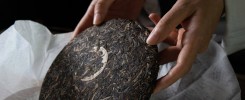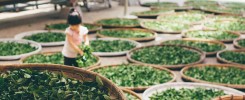Among all the teas in the world, few have sparked as much curiosity and devotion as Pu-erh tea. Originating from Yunnan, China, this ancient tea is unlike green, black, or oolong tea—it’s a living tea that evolves over time, deepening in aroma and complexity. To tea lovers and collectors, Pu-erh is not just a beverage—it’s a journey through time, culture, and taste. But what exactly makes Pu-erh tea so special? Let’s explore its unique nature from cultivation to cup.
Table of Contents
1. A Tea That Improves With Age
Most teas are best enjoyed fresh, when their floral or grassy notes are still vibrant. Pu-erh, however, is one of the few teas that matures beautifully with age—much like fine wine. The secret lies in its fermentation process, where beneficial microorganisms slowly transform the tea leaves over time.
A young raw (sheng) Pu-erh can taste bold, slightly bitter, and energetic, while an aged one becomes mellow, smooth, and deeply complex. Well-stored Pu-erh develops rich earthy notes, hints of dried fruit, and even subtle sweetness. This natural evolution gives Pu-erh a soul—each cake tells its own story depending on where and how it was aged.
2. Fermentation: Nature’s Craftsmanship
The magic of Pu-erh lies in its microbial fermentation, a process that continues long after production. Unlike other teas, which are oxidized and then stabilized, Pu-erh remains biologically active. Its microbes—primarily from the environment of Yunnan’s forests and the tea factories themselves—interact with air, humidity, and time.
There are two main types:
- Raw (Sheng) Pu-erh, which ferments naturally and slowly over years.
- Ripe (Shou) Pu-erh, which undergoes an accelerated fermentation process developed in the 1970s to mimic aged sheng tea.
This controlled fermentation is an art form. The temperature, moisture, and turning of the leaves all influence the final taste. Experienced tea masters know how to guide, not force, this living transformation—allowing nature to shape the tea’s final character.
3. The Terroir of Yunnan
Another reason Pu-erh stands apart is its origin. The tea comes exclusively from Yunnan Province, one of the oldest tea-growing regions in the world. The local environment—high altitude, misty mountains, ancient tea trees, and rich red soil—creates the ideal conditions for high-quality leaves.
Many of Yunnan’s tea trees are hundreds or even thousands of years old, growing deep in forests rather than on manicured plantations. These “ancient arbor” trees produce leaves with more nutrients, thicker texture, and a deeper flavor profile.
Just as grapes reflect their terroir, so does Pu-erh. A tea from Bulang Mountain tastes robust and bitter-sweet; one from Yiwu is soft, floral, and elegant. For serious drinkers, exploring Pu-erh from different mountains is like tasting the geography of Yunnan itself.
4. Health Benefits That Stand the Test of Time
For centuries, Chinese medicine has valued Pu-erh for its digestive and detoxifying properties. Modern research now supports many of these traditional beliefs. Studies show that Pu-erh tea may help:
- Lower cholesterol and triglyceride levels
- Aid digestion and fat metabolism
- Regulate blood sugar
- Support gut health through beneficial bacteria
Unlike highly caffeinated teas, Pu-erh delivers a gentle energy—calming yet alerting, making it perfect for long working hours or meditation. Many tea drinkers describe it as having a grounding effect, bringing clarity and balance.
5. A Cultural Legacy in Every Cup
Pu-erh is not just a tea; it’s a symbol of Chinese tea culture and heritage. It was once a prized commodity along the ancient Tea Horse Road, traded across Tibet, Myanmar, and beyond. Its compressed form—bricks, cakes, and tuocha—was designed for long transport through humid and rugged terrains.
Today, Pu-erh continues to bridge past and present. Collectors treasure aged cakes as investments, while everyday tea drinkers enjoy it as part of a mindful lifestyle. In China, sharing Pu-erh signifies hospitality and respect; abroad, it’s becoming a favorite among health-conscious consumers seeking authenticity and tradition.
6. How to Choose and Enjoy Pu-erh
If you’re new to Pu-erh, start small. Buy from trusted tea merchants who specialize in Yunnan teas, and try both raw and ripe types to discover your preference.
- Ripe Pu-erh: Smooth, earthy, and ready to drink immediately. Great for newcomers.
- Raw Pu-erh: Fresher, bolder, and more complex with age. Best for those who enjoy exploring tea’s evolution.
When brewing, use short infusions with boiling water. A good Pu-erh can be steeped multiple times, revealing new layers of flavor with each brew. Always rinse the leaves once before drinking—it awakens the tea and cleans away dust from storage.
Final Thoughts
So, what is special about Pu-erh tea? It’s more than its earthy flavor or deep color—it’s the way it connects nature, time, and craftsmanship in every sip. Pu-erh embodies patience, transformation, and history. It teaches us that good things—whether tea or life—often take time to mature.
For the true tea lover, Pu-erh is not just something to drink. It’s something to experience, to study, and to treasure. Every cup is an invitation to slow down, reflect, and taste the wisdom of centuries.

